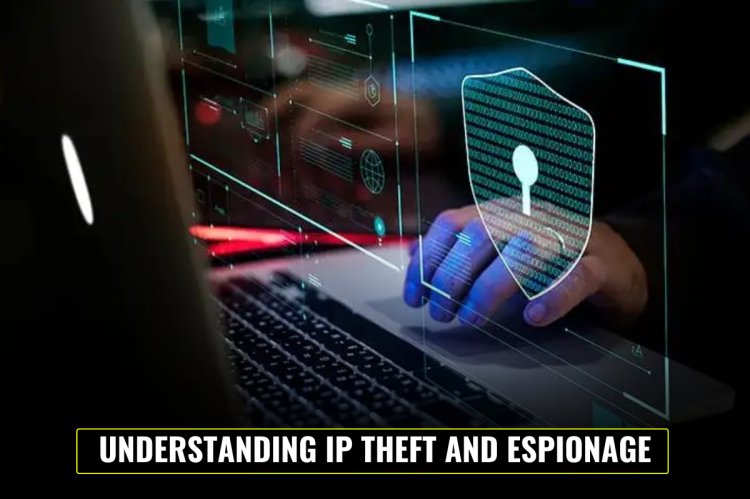Understanding IP Theft and Espionage
Intellectual property (IP) theft and corporate espionage have become major threats in the digital age, costing companies billions of dollars annually. With the rise of cyberattacks, insider threats, and sophisticated espionage techniques, businesses are struggling to protect their trade secrets, patents, and proprietary data. This blog explores the methods used in IP theft, high-profile cases, the impact on businesses, and strategies to safeguard intellectual assets.

Introduction
In an era where information is more valuable than ever, intellectual property (IP) theft and corporate espionage pose significant threats to businesses worldwide. Companies invest heavily in research and development (R&D) to stay ahead of competitors, only to find their proprietary data stolen or compromised. Whether through cyberattacks, employee leaks, or state-sponsored espionage, IP theft leads to massive financial losses and weakened competitive advantages.
From high-tech industries to pharmaceutical giants, no sector is immune to this growing menace. The rise of digital transformation has only expanded attack surfaces, making it easier for cybercriminals and rival entities to infiltrate corporate networks. This blog delves into how companies lose billions in stolen secrets and what they can do to protect their valuable assets.
1. What Is Intellectual Property Theft?
Intellectual property theft refers to the unauthorized use, reproduction, or distribution of a company’s trade secrets, patents, trademarks, copyrights, or proprietary information. It includes everything from counterfeiting products to stealing proprietary technology and business strategies.
Types of IP Theft:
- Trade Secret Misappropriation: Unauthorized access or disclosure of confidential business information.
- Patent Infringement: Unauthorized use of patented technology.
- Trademark Counterfeiting: Fake products bearing registered brand names.
- Copyright Piracy: Unauthorized reproduction of copyrighted materials.
- Data Breaches: Theft of proprietary databases and customer information.
2. Common Methods of Corporate Espionage
IP theft can occur through various sophisticated means, including cyber and physical infiltration. Below are the most common methods:
Cyberattacks
Hackers use malware, phishing, and ransomware to gain unauthorized access to corporate networks and extract sensitive data.
Insider Threats
Employees or contractors may leak confidential data, either maliciously or unintentionally, making internal security a critical concern.
Social Engineering
Attackers manipulate employees into revealing confidential information by impersonating trusted entities or exploiting psychological tactics.
Physical Theft
Corporate spies may steal hard drives, documents, prototypes, or other physical assets containing sensitive information.
State-Sponsored Espionage
Government-backed cyber espionage operations target foreign companies to steal advanced technologies and trade secrets.
To know more about this you can follwo the link below:
3. The Economic Impact of IP Theft
Intellectual property theft is not just a corporate issue but an economic one. The consequences include:
Revenue Loss
Companies lose market share to counterfeiters and competitors using stolen innovations, leading to reduced sales and profits.
R&D Setbacks
Years of investment in research and development can be rendered useless when proprietary data is leaked.
Job Losses
Reduced profitability can lead to layoffs and downsizing, impacting the workforce and overall economy.
Weakened National Security
Stolen defense and technology secrets can compromise national security, especially in industries like aerospace, cybersecurity, and energy.
4. How Companies Can Protect Their IP
Businesses must adopt a multi-layered approach to safeguard their intellectual property.
4.1 Strengthening Cybersecurity
- Implement multi-factor authentication (MFA) and encryption to protect sensitive data.
- Conduct regular security audits and vulnerability assessments to detect weaknesses.
- Use firewalls and intrusion detection systems (IDS) to monitor network traffic.
4.2 Employee Awareness and Training
- Educate employees on recognizing phishing attempts and social engineering tactics.
- Enforce strict access controls to limit data exposure.
- Establish a culture of cyber hygiene to minimize security risks.
4.3 Legal and Compliance Measures
- File patents, trademarks, and copyrights to establish legal protection.
- Use non-disclosure agreements (NDAs) and strong contractual clauses to prevent leaks.
- Enforce trade secret laws and pursue legal action against IP theft.
4.4 Monitoring and Incident Response
- Deploy AI-driven monitoring tools to detect unauthorized access in real time.
- Have a rapid incident response plan to mitigate damages in case of a data breach.
- Conduct regular forensic investigations to trace cyber intrusions.
Conclusion
As businesses continue to rely on digital infrastructure and innovation, the threat of IP theft and espionage remains a critical challenge. Companies that fail to secure their intellectual assets risk severe financial losses, legal battles, and reputational damage. By implementing robust cybersecurity strategies, enforcing strict internal policies, and staying ahead of evolving threats, organizations can protect their valuable trade secrets and maintain a competitive edge in the global market.
Understanding and combating IP theft is not just a corporate responsibility but an essential measure for economic stability and national security. Investing in prevention today can save businesses from catastrophic losses in the future.












